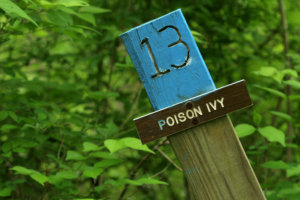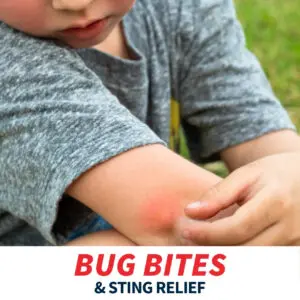The Itchy Side of Nature: Poison Ivy, Oak & Sumac
 Going outside to garden, take a nature hike, or just to enjoy the weather are activities that can help us relax and reset our minds from the busy day-to-day. However, when around areas with certain plant life, it is imperative to stay alert and practice caution. Plants like poison ivy, poison oak, and poison sumac can appear innocent to the untrained eye, but all have the potential to cause an allergic reaction that can leave you in pain and itchy for weeks.
Going outside to garden, take a nature hike, or just to enjoy the weather are activities that can help us relax and reset our minds from the busy day-to-day. However, when around areas with certain plant life, it is imperative to stay alert and practice caution. Plants like poison ivy, poison oak, and poison sumac can appear innocent to the untrained eye, but all have the potential to cause an allergic reaction that can leave you in pain and itchy for weeks.
Plant Identification
While the general rule-of-thumb for poison ivy identification is, “Leaves of three, let it be,” some species of these plants break this rule having more than three leaflets, while other non-toxic plants may also have three leaves in a cluster. Being able to positively identify and avoid a toxic plant is the only real way to guarantee you will not experience a negative reaction.
- Poison Ivy: Found everywhere in the U.S. except California, Alaska, and Hawaii. This plant may grow as ground cover, low shrub, or vine, usually climbing up trees. The leaves are solid green in clusters of three per stem. The leaves may appear dull or glossy, and have pointed tips. The thin roots on the vines make them appear fuzzy or hairy. During summer, yellow-green flowers will bloom followed by whitish berries. In the fall, the leaves change to yellow and red.
- Poison Oak: Found in the Southeast or along the West Coast of the U.S. The leaves resemble oak leaves, typically growing in clusters of three, but, depending on the specific kind, may also grow in clusters of five, seven or nine leaves. It typically grows like a shrub and produces greenish-yellow or white berries.
- Poison Sumac: Mainly located in swampy areas, along the Mississippi River, or throughout the Southeast. This plant usually has seven to thirteen leaflets arranged in pairs. Sometimes, the leaves will have black or dark brown spots, which are filled with the toxin urushiol. In fall, the leaves turn red, yellow, and pinkish. It typically grows as a woody shrub that has glossy cream or pale yellow berries.
In any case, if you notice the plant has a dull, waxy sheen, stay away as this is the urushiol oil that you are needing to stay away from. For visual representation of each plant, click here.
Preventing Reactions
Each of these plants releases a toxic oil called urushiol when simply brushed or touched on any part – even the roots. Roughly 80 – 90% of people will develop some sort of reaction, most commonly a very itchy, blistery rash. If you know you are going to be in an area where these plants may be present, be sure to use preventative steps to avoid direct contact or a reaction:
- Use Ivy Block: This topical lotion is available for purchase at most drugstores and is suitable for most over the age of 6 years old. It essentially creates an extra barrier that will keep the skin from absorbing the toxic oil.
- Wear Protective Clothing: Wearing long sleeves and long pants tucked into boots is perfect for a hike if you may accidentally brush up against these plants. If you are going to be removing any of these from your garden, be sure to also add eyewear and gloves to your ensemble to provide more coverage.
If you made any sort of contact with the plant on your skin, washing the area with lukewarm water and soap within 15 minutes may actually allow you to completely wash away the oils, thus preventing a reaction. Rashes will develop around 24 – 48 hours after exposure. If your clothes are what made contact, take care in removing them and washing them immediately, preferably without any other items so the oil doesn’t spread to something else. Also, be sure to rinse your machine afterwards to remove any traces that may have been left behind.
Treating the Rash
Unfortunately, it isn’t always so simple to prevent a reaction from occurring, so it is important to know what to do to get relief should a rash develop. Regardless of which of these plants you come into contact with, the rash will be the same, so treatment will work for all. If the rash is small, a wet compress, cool bath and calamine lotion will help bring relief to the itch. An antihistamine may also be used to help with itching, but be sure to consult with your doctor before taking any medication, especially if it is a child with the rash. A severe allergic reaction to the plants requires immediate medical attention as life-threatening anaphylaxis may occur.
How to Rid Your Yard of the Plants
To truly get rid of the plants, the entire root system will need to be removed as they are able to grow back from any pieces left behind. Again, be sure that if you are pulling these yourself, you wear all proper clothing to keep yourself covered from exposure and clean thoroughly. To avoid the risk, contact a professional removal company to take care of these for you. Another option would be to use an herbicide that is specifically formulated to kill the plants, but they are usually strong enough to kill any other plants around the area, so use caution within your landscape. The only thing you should NOT do to eradicate them is burn them. When the plants are burned, the toxic oils can be inhaled, causing potentially serious reactions within your lungs, and can even be harmful to those standing downwind from the fire.
Nature can be both beautiful and quite unforgiving at times. Being knowledgeable about the plants around you will help you to avoid unnecessary problems and allow you to fully enjoy the outdoors. If you have questions about getting relief for your poison ivy, oak, or sumac reaction, contact us today.




